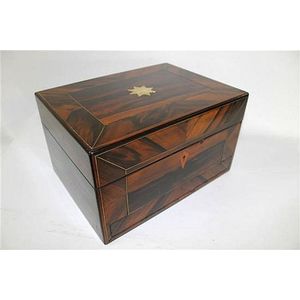Indo-Portuguese Rosewood Contador Box with Ivory Inlay
Rare antique 17th century Indo-Portuguese rosewood contador box. The fall front revealing a fitted interior with a faux three drawer front long drawer, a central pair of faux front drawers as one deep drawer, flanked by a pair of single drawers, all inlaid in ivory. The outer casket inlaid with ivory and brass bound, fitted with drop bronze carry handles, forged iron hinges and lock, some losses. Private collection Melbourne. Approx 21.5 cm high, 34 cm wide, 25 cm depth
You must be a subscriber, and be logged in to view price and dealer details.
Subscribe Now to view actual auction price for this item
When you subscribe, you have the option of setting the currency in which to display prices to $Au, $US, $NZ or Stg.
This item has been sold, and the description, image and price are for reference purposes only.
- Rosewood - A dense timber that varies in shade to very light brown to almost black. When rosewood is cut and sanded the colour of the timber will turn black, and after polishing and exposure to daylight, the surface will gradually lighten over time to light brown with black streaks.
The name comes from the odour emanating from the timber when it is planed, sanded or cut.
Rosewood was very popular for use in Victorian furniture in the second half of the 19th century, and at that time most of the rosewood was imported from Brazil. However it also grows in India and Indonesia.
It is used in the sold for chairs and table legs, but for carcase furniture such as side cabinets and bookcases, and for table tops it is always used as a veneer. - Bronze - An alloy of copper and tin, traditionally in the proportions of about 9 parts of copper to 1 part of tin.
The discovery of bronze in Western Asia in the 4th century enabled people to create metal objects which were superior to those previoulsy possible because of its strength and hardness, and it has been used throughout the world for weapons, coins, tools, statuary and other decorative items.
It is very fluid in a molten state, and its hardness, strength when set, and non-corrosive properties makes it most suitable for casting sculpture. - Faux - A French word meaning "false", but when used in decorative arts, the intention is not to deceive, but to simulate the decorative effects of the more expensive material it is imitating. The term " faux bois" meaning "false wood" refers to a furniture item that has been decorated with a marked grain (woodgrain finish) to imitate a more expensive timber.
- Ivory - Ivory is a hard white material that comes from the tusks of elephants, mammoth, walrus and boar, or from the teeth of hippopotamus and whales. The ivory from the African elephant is the most prized source of ivory. Although the mammoth is extinct, tusks are still being unearthed in Russia and offered for sale.
Ivory has been used since the earliest times as a material for sculpture of small items, both in Europe and the east, principally China and Japan.
In Asia ivory has been carved for netsuke, seals, okimono, card cases, fan supports, animals and other figures and even as carved tusks.
In the last 200 years in Europe ivory has been used to carve figures, for elaborate tankards, snuff boxes, cane handles, embroidery and sewing accessories, in jewellery and as inlay on furniture. Its more practical uses include being used for billiard balls, buttons, and a veneers on the top of piano keys.
The use and trade of elephant ivory have become controversial because they have contributed to Due to the decline in elephant populations because of the trade in ivory, the Asian elephant was placed on Appendix One of the Convention on International Trade in Endangered Species (CITES), in 1975, and in January 1990, the African elephant was similarly listed. Under Appendix One, international trade in Asian or African elephant ivory between member countries is forbidden. Unlike trade in elephant tusks, trade in mammoth tusks is legal.
Since the invention of plastics, there have been many attempts to create an artificial ivory
Visually similar items

An American wicker picnic basket, 30 x 74 x 50 cm
Sold by
in
for
You can display prices in $Au, $US, $NZ or Stg.

A Victorian coromandel and brass inlaid casket with hinged cover and with a drawer with concealed mechanism. Width 30 cm
Sold by
in
for
You can display prices in $Au, $US, $NZ or Stg.

Tramp art jewellery box, Australian cedar and velvet with gilt metal mounts, circa 1890 15 cm high, 28 cm wide, 19 cm deep
Sold by
in
for
You can display prices in $Au, $US, $NZ or Stg.

A fine Sadeli Anglo-Indian work box, 19th century, ivory and ebony inlay on padouk, with fitted interior, 12.5 cm high, 27 cm across
Sold by
in
for
You can display prices in $Au, $US, $NZ or Stg.
